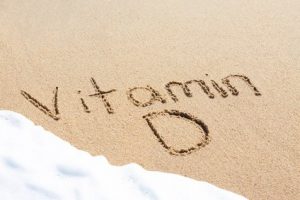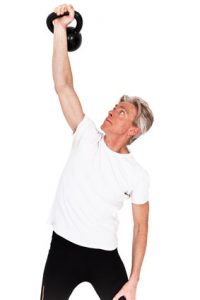Why Is Vitamin D Research So Controversial?
Author: Dr. Stephen Chaney
 Millions of Americans lose muscle strength as they age, something called sarcopenia. This is not a trivial matter. Loss of muscle mass:
Millions of Americans lose muscle strength as they age, something called sarcopenia. This is not a trivial matter. Loss of muscle mass:
- Leads to loss of mobility. It can also make it difficult to do simple things like lifting your grandchild or carrying a bag of groceries.
- Increases your risk of falling. This often leads to serious fracture which increases your of dying prematurely. In fact, bone fractures increase your risk of dying by 3-fold or more. Even in those who recover their mobility and quality of life may never be the same.
- Lowers your metabolic rate. This increases your risk of obesity and all the diseases that are associated with obesity.
Loss of muscle strength as we age is preventable. There are several things we can do to preserve muscle strength as we age, but in today’s article I will focus on the effect of vitamin D on muscle strength.
What if something as simple as preventing vitamin D deficiency could improve muscle strength as we age? That idea has been around for a decade or more. But, for reasons I will detail below, it has proven controversial. Let me start by sharing a recent study on vitamin D and muscle strength (N Aspell et al, Clinical Investigations in Ageing, volume 2019:14, pages 1751-1761).
How Was The Study Done?
 The data for this study came from 4157 adults who were enrolled in the English Longitudinal Study On Aging. Participants in this study were all over the age of 60 and were still living in their own homes. The general characteristics of the study population were:
The data for this study came from 4157 adults who were enrolled in the English Longitudinal Study On Aging. Participants in this study were all over the age of 60 and were still living in their own homes. The general characteristics of the study population were:
- Their average age was 69.8 with 45% male and 55% female.
- While 76% of the participants rated their health as “good” or above
-
- 73% were overweight or obese.
-
- 54% had a longstanding disease that limited mobility.
-
- 29% were taking multiple medications.
Serum 25-hydroxy vitamin D levels were determined as a measure of vitamin D status.
- 22% of the participants were vitamin D deficient (<30 nmol/L 25-hydroxy vitamin D).
- 34% of the participants were vitamin D insufficient (between 30 and 50 nmol/L 25-hydroxy vitamin D).
- 46% of the participants had adequate vitamin D status (>50 nmol/L 25-hydroxy vitamin D).
Muscle strength was assessed by a handgrip strength test with the dominant hand. Muscle performance was assessed with something called the short physical performance battery (SPPB), consisting of a walking speed test, a repeated chair raise test, and a balance test.
Does Low Vitamin D Make You Weak?
 When the data on handgrip strength were analyzed:
When the data on handgrip strength were analyzed:
- Only 22% of the participants who had adequate vitamin D status had low handgrip strength.
- 40% of participants who were vitamin D deficient had low handgrip strength. That’s almost a 2-fold difference.
- Handgrip strength increased linearly with vitamin D status.
-
- The relationship between vitamin D status and handgrip strength was highly significant (p<001).
-
- The beneficial effect of vitamin D status on handgrip strength plateaued at around 55-69 nmol/L 25-hydroxy vitamin D. In other words, you need adequate vitamin D status to support muscle strength, but higher levels provide no additional benefit.
When the data on muscle performance (the SPPB test) were analyzed:
- Only 8% of the participants who had adequate vitamin D status scored low on this test.
- 25% of participants who were vitamin D deficient scored low on this test. That’s a 3-fold difference.
- Muscle performance also increased linearly with vitamin D status.
-
- The relationship between vitamin D status and muscle performance was also highly significant (p<001).
-
- The beneficial effect of vitamin D status on muscle performance also plateaued at around 55-69 nmol/L 25-hydroxy vitamin D.
The authors concluded: “Vitamin D deficiency was associated with impaired muscle strength and performance in a large study of community-dwelling older people. It is generally accepted that vitamin D deficiency should be reversed to prevent bone disease. This strategy may also protect skeletal muscle function in aging.”
Why Is Vitamin D Research So Controversial?
 You can be forgiven if you are saying to yourself: “I’ve heard this sort of thing before. I see a blog or headline claiming that vitamin D has a certain benefit, but it’s usually followed by later headlines saying those claims are false. Why can’t the experts agree? Is all vitamin D research bogus?”
You can be forgiven if you are saying to yourself: “I’ve heard this sort of thing before. I see a blog or headline claiming that vitamin D has a certain benefit, but it’s usually followed by later headlines saying those claims are false. Why can’t the experts agree? Is all vitamin D research bogus?”
The relationship between vitamin D status and muscle strength is no different.
- Many, but not all, studies looking at the association between vitamin D status and muscle strength find that vitamin D status affects muscle strength.
- However, many randomized, placebo-controlled clinical trials looking at the effect of vitamin D supplementation on muscle strength have come up empty.
A meta-analysis (L Rejnmark, Therapeutic Advances in Chronic Disease, 2: 25-37, 2011) of randomized, placebo-controlled clinical trials of vitamin D supplementation and muscle strength provides insight as to why so many of them come up empty.
The meta-analysis combined data from 16 clinical trials. The conclusions were similar to what other meta-analyses have found:
- Seven of the studies showed a benefit of vitamin D supplementation on muscle strength. Nine did not.
- When the data from all 16 studies were combined, there was only a slight beneficial effect of vitamin D supplementation on muscle strength.
However, it was in the discussion that the reason for these discrepancies became apparent. There were three major deficiencies in study design that were responsible for the discrepancies.
1) There was a huge difference in study design.
- The subjects were of different ages, genders, and ethnicity.
- The dose of vitamin D supplementation varied.
- Different measures of muscle strength and performance were used.
Until the scientific and medical community agree on a standardized study design it will be difficult to obtain consistent results.
While this deficiency explains the variation in outcomes from study to study, there are two other deficiencies in study design that explain why many of the studies failed to find an effect of vitamin D on muscle strength. I call this “Garbage In, Garbage Out”. Simply put, if the study has design flaws, it may be incapable of detecting a positive effect of vitamin D on muscle strength.
2) Many of the studies did not measure vitamin D status of the participants at the beginning of the study.
- The results of the study described above show that additional vitamin D will be of little benefit for anyone who starts the study with an adequate vitamin D status.
- In the study above 46% of the participants had adequate vitamin D status. This is typical for the elderly community. When almost 50% of the participants in a study have adequate vitamin D status at the beginning of a study it becomes almost impossible to demonstrate a beneficial effect of vitamin D supplementation on any outcome.
It is essential that future studies of vitamin D supplementation focus on participants who have low vitamin D status. Otherwise, you are almost guaranteeing a negative outcome.
3) Most of the studies ignored the fact that vitamin D status is only one of three factors that are essential for muscle strength.
- In the case of muscle strength, especially in the elderly, the three essentials are vitamin D, protein, and exercise. All three are needed to maintain or increase muscle strength. Simply put, if one is missing, the other two will have little or no effect on muscle strength. Unfortunately, you cannot assume that exercise and protein intake are adequate in older Americans:
- Many older adults don’t get enough exercise because of physical limitations.
-
- Many older adults do not meet RDA recommendations for protein intake). That’s because physical and/or psychological limitations often interfere with their ability and interest in preparing healthy meals.
-
- To make matters even worse, many experts feel that the RDA underestimates the protein requirements of the elderly).
Unfortunately, many clinical studies on the effect of vitamin D supplementation and muscle strength fail to include exercise and adequate protein intake in the study. Such clinical trials are doomed to failure.
Now you know why vitamin D research is so controversial. Until the scientific and medical community get their act together and perform better designed experiments, vitamin D research will continue to be controversial and confusing.
What Does This Mean For You?
 Loss of muscle mass as we age is not a trivial matter. As described above, it:
Loss of muscle mass as we age is not a trivial matter. As described above, it:
- Leads to loss of mobility.
- Increases your risk of falling. This often leads to serious fractures which increase your risk of disability and death.
- Lowers your metabolic rate, which increases your risk of obesity and obesity-related diseases.
So, what can you do prevent loss of muscle mass as you age? The answer is simple:
- Aim for 25-30 grams of high-quality protein in each meal.
-
- That protein can come from meat, fish, eggs, or vegetable sources such as beans, nuts, and seeds.
-
- That doesn’t mean you need to consume an 8-ounce steak or a half chicken. 3-4 ounces is plenty.
-
- However, it does mean you can’t subsist on green salads and leafy greens alone. They are healthy, but you need to include a good protein source if you are going to meet your protein needs.
- Aim for 150 minutes of moderate intensity exercise per week.
-
- At least half of that exercise should be resistance exercise (lifting weights, for example).
-
- If you have physical limitations, consult your doctor and work with a physical therapist or personal trainer to design resistance exercises you can do.
-
- Aim for a variety of resistance exercises. You will only strengthen the muscles you exercise.
- Aim for an adequate vitamin D status.
-
- Start with a multivitamin containing at least 800 IU of vitamin D3.
-
- Because there is large variation in the efficiency with which we convert vitamin D to 25-hydroxy vitamin D, you should get your serum 25-hydroxyvitamin D tested on a yearly basis. Your health professional can tell you if you need to take larger amounts of vitamin D3.
-
- This study suggests that a serum 25-hydroxy vitamin D level of 55-69 nmol/L is optimal, and higher levels provide no additional benefit. That means there is no need to take mega-doses of vitamin D3 unless directed by your health professional.
The Bottom Line
A recent study looked at the effect of vitamin D status on muscle strength and performance in a healthy population with an average age of 69.
When they looked at handgrip strength:
- Only 22% of the participants with an adequate vitamin D status had low handgrip strength.
- 40% of participants who were vitamin D deficient had low handgrip strength. That’s almost a 2-fold difference.
- Handgrip strength increased linearly with vitamin D status.
When they looked at muscle performance:
- Only 8% of the participants with an adequate vitamin D status scored low on this test.
- 25% of participants who were vitamin D deficient scored low on this test. That’s a 3-fold difference.
- Muscle performance also increased linearly with vitamin D status.
The authors concluded: “Vitamin D deficiency was associated with impaired muscle strength and performance in a large study of community-dwelling older people. It is generally accepted that vitamin D deficiency should be reversed to prevent bone disease. This strategy may also protect skeletal muscle function in aging.”
If we look at the research more broadly, there are three factors that are essential for maintaining muscle mass as we age: exercise, protein, and vitamin D. Therefore, my recommendations are to:
1) Aim for 25-30 grams of high-quality protein in each meal.
2) Aim for 150 minutes of moderate intensity exercise per week. At least half of that exercise should be resistance exercise.
3) Aim for an adequate vitamin D status (>50 nmol/L of serum 25-hydroxy vitamin D). A good place to start is with a multivitamin providing at least 800 IU of vitamin D3.
For more details on my recommendations and a discussion of why studies on vitamin D supplementation are often confusing, read the article above.
These statements have not been evaluated by the Food and Drug Administration. This information is not intended to diagnose, treat, cure or prevent any disease
